
Have you ever felt overwhelmed by a wave of emotions, unsure of how to navigate the storm brewing inside you? Perhaps a fleeting comment from a colleague lingers in your mind all day, or a small setback spirals into a flood of negative thoughts. You’re not alone. Many of us grapple with our feelings, often viewing negative emotions as adversaries to be suppressed or ignored.
But what if I told you that these negative emotions aren’t obstacles to be avoided but valuable signals guiding you toward personal growth and well-being? What if, instead of running from them, you could harness their power to transform your life?
Welcome to a new perspective on emotional mastery. Drawing on the groundbreaking work of Dr. James Gross, a leading expert in emotion regulation at Stanford University, insights from cognitive-behavioral therapy (CBT); and the transformative methods of Byron Katie, a prominent teacher in self-inquiry and cognitive restructuring, this article will equip you with proven strategies to understand and manage your emotions effectively. We’ll explore how changing the way you think can turn negative feelings into constructive actions, leading to enhanced well-being and reduced suffering.
Imagine being able to face challenging situations with confidence, turning potential stressors into opportunities for growth. By the end of this journey, you’ll have practical tools to not only master your own emotions but also to support others in navigating theirs.
Are you ready to transform the way you experience your emotions? Let’s dive in and discover how understanding and regulating your feelings can lead to a more fulfilling and balanced life.
Understanding Emotion Regulation
What Is Emotion Regulation?
Definition
Emotion regulation is the process by which we influence the emotions we experience, when we experience them, and how we express them. It’s a fundamental aspect of our emotional lives that allows us to navigate various situations effectively. Rather than merely suppressing or amplifying emotions, emotion regulation involves a nuanced approach to understanding and managing our feelings.
Importance
Emotion regulation is crucial because it empowers us to decide whether our emotions are helpful or unhelpful in a particular context. It’s not about controlling or dismissing our emotions but about appreciating them and making informed choices on how to respond. This discernment can lead to healthier relationships, better decision-making, and overall improved well-being.
For example, feeling nervous before a job interview is natural. Instead of trying to eliminate that nervousness, recognizing it as a sign that the interview matters to you can motivate you to prepare thoroughly. By understanding and channeling this emotion constructively, you turn a potentially paralyzing feeling into a driving force for success.
Dr. James Gross, a leading researcher in emotion regulation at Stanford University, describes emotion regulation as a suite of processes that allow us to understand our emotions and make informed decisions about them. According to Dr. Gross, emotion regulation isn’t just about “fixing” or “controlling” our feelings. It involves detecting and appreciating the emotions we have, coming to clarity about whether they’re serving us in a given situation, and, if not, employing strategies to influence them.
He emphasizes that healthy emotion regulation is more than swatting away negative emotions and increasing positive ones. It’s about a full set of processes that underlie our ability to appreciate the emotions we’re experiencing and then decide whether those emotions are helpful or harmful in a particular context.
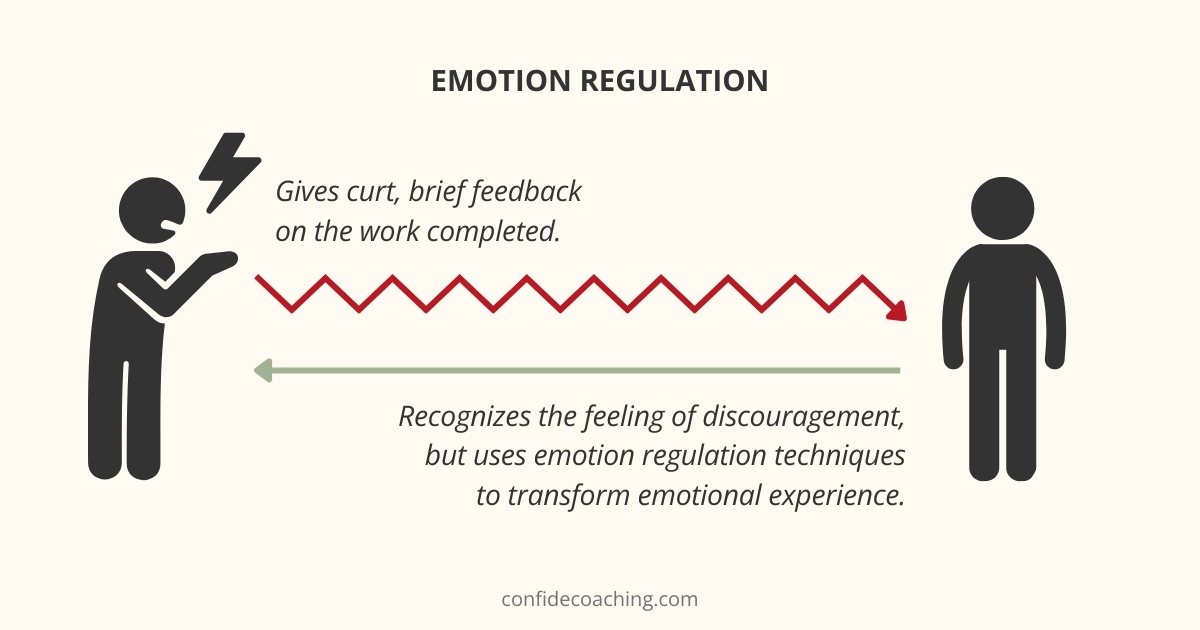
Differentiating Emotion Regulation from Mood Regulation and Coping
Understanding the differences between emotion regulation, mood regulation, and coping helps us apply the right strategies to manage our emotional experiences effectively.
Emotion Regulation
Emotion regulation involves managing immediate emotional responses to specific events. It’s about recognizing and influencing how we react in the moment.
Example: If someone cuts you off in traffic and you feel a surge of anger, emotion regulation strategies help you decide whether to honk aggressively or take a deep breath and let it go.
Mood Regulation
Mood regulation addresses longer-lasting emotional states that may not have a clear starting point. Moods are less intense than emotions but more enduring and generalized.
Example: If you wake up feeling irritable without a specific reason, mood regulation techniques like exercising, engaging in a hobby, or practicing mindfulness can help improve your overall emotional state.
Coping
Coping refers to how we handle stressors and challenging situations, involving both emotional and problem-solving strategies. Coping mechanisms can be adaptive (healthy) or maladaptive (unhealthy).
Example: If you’re stressed about an upcoming exam:
- Adaptive coping: Create a study schedule (problem-focused coping) or seek support from classmates (social coping).
- Maladaptive coping: Procrastinate and avoid studying altogether.
Why These Distinctions Matter
Recognizing these distinctions allows you to select the most appropriate approach:
- For Immediate Reactions: Use emotion regulation techniques to manage specific emotional responses.
- For Prolonged States: Apply mood regulation strategies to adjust your overall emotional climate.
- For Stressful Situations: Employ coping mechanisms to address broader challenges that may involve both emotional and practical aspects.
By understanding whether you’re dealing with a fleeting emotion, a sustained mood, or a stressful situation requiring coping, you can tailor your strategies to navigate your feelings more effectively and maintain emotional well-being.
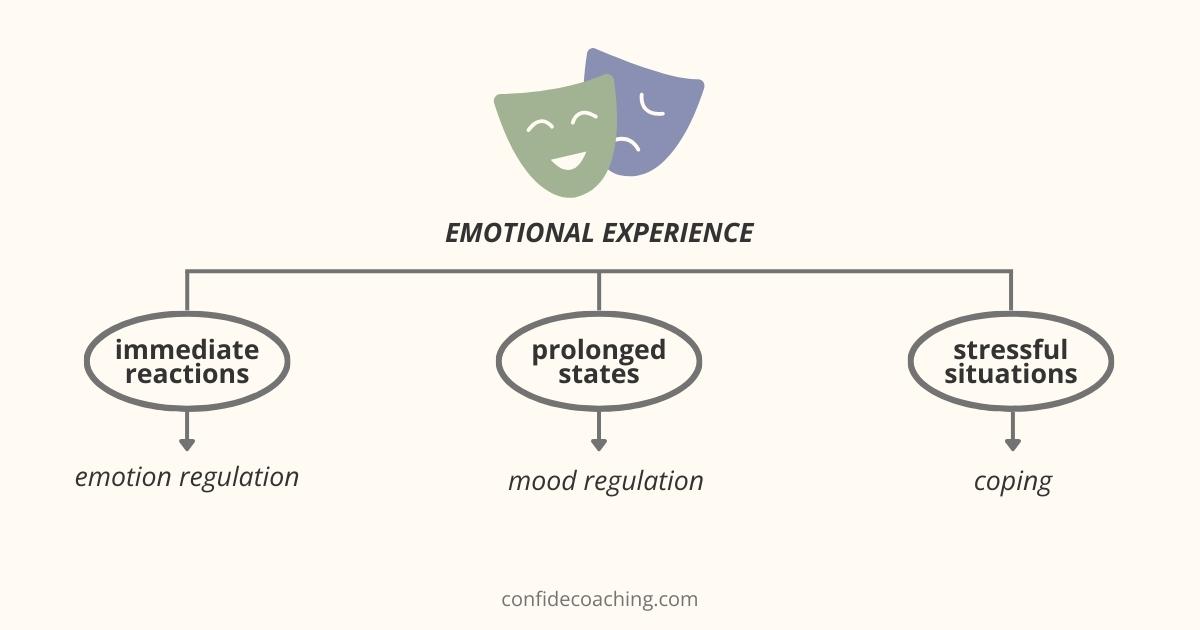
Recognizing the Value of Negative Emotions
Negative Emotions as Important Signals
Emotions Provide Information
Negative emotions often get a bad reputation, leading many to believe they should be avoided or suppressed. However, these feelings are essential indicators that provide valuable information about our internal state and external environment. Just like physical pain alerts us to potential bodily harm, negative emotions signal that something in our lives requires attention.
For instance, feelings of anxiety, sadness, or anger can highlight unmet needs, unresolved issues, or situations that conflict with our values and goals. By paying attention to these emotional cues, we can identify areas that may need change, improvement, or acceptance.
Example
Consider the common experience of feeling anxious before a public speaking event. This anxiety isn’t merely an obstacle to overcome; it’s a signal emphasizing the importance of the occasion. The nervousness indicates that you care about the outcome and want to perform well. Recognizing this, you might decide to invest extra time in preparing your presentation, practicing your delivery, and anticipating possible questions. The negative emotion, in this case, serves as a motivating force to enhance your readiness and confidence.
Similarly, if you feel uneasy about a new job opportunity, that discomfort might prompt you to evaluate whether the position aligns with your long-term career goals or personal values. The negative emotion guides you to reflect more deeply before making a decision.
Deciding Whether to Change or Embrace an Emotion
Assessing Helpfulness
Not all negative emotions require immediate action to change or eliminate them. The crucial step is to assess whether the emotion serves a constructive purpose in the current situation. Ask yourself:
- Is this emotion providing valuable insight?
- Does it motivate me to take positive action?
- Is it proportional to the circumstances I’m facing?
By evaluating the usefulness of the emotion, you can make an informed decision about how to respond.
Embracing Useful Emotions
Sometimes, diving deeper into negative feelings can lead to significant personal growth and problem-solving. Embracing these emotions allows you to understand their root causes and address underlying issues.
For example, suppose you’re feeling frustrated with a lack of progress on a personal project. Instead of dismissing the frustration, you might explore why you feel this way. Perhaps it reveals that you need to adjust your approach, seek additional resources, or set more realistic goals. By acknowledging and working through the emotion, you turn a negative feeling into a catalyst for improvement.
When to Consider Changing the Emotion
On the other hand, if a negative emotion is unhelpful—causing distress without offering any constructive value—it may be appropriate to employ emotion regulation strategies to modify it. Chronic feelings of jealousy, resentment, or unnecessary guilt can hinder your well-being and relationships. In such cases, techniques like cognitive reappraisal (which we’ll delve into later) can help you shift your perspective and reduce the intensity of these emotions.
Practical Steps to Assess and Respond to Emotions
1. Pause and Reflect
When you experience a negative emotion, take a moment to pause. Instead of reacting impulsively, allow yourself to feel the emotion without judgment.
2. Identify the Source
Ask yourself what’s triggering this emotion. Is it a specific event, thought pattern, or interaction? Understanding the source can provide clarity.
3. Evaluate the Emotion’s Purpose
Determine whether the emotion is serving a helpful purpose. Is it alerting you to something important, or is it amplifying unnecessary stress?
4. Decide on a Course of Action
- If Helpful: Embrace the emotion. Use it as motivation to make necessary changes or to address underlying issues.
- If Unhelpful: Consider strategies to regulate and alter the emotion, such as reframing your thoughts, seeking support, or practicing relaxation techniques.
Real-Life Application
Imagine you’re feeling overwhelmed by a project at work. The stress is causing you to lose sleep and affecting your performance. Instead of pushing the emotion aside, recognize that it’s signaling a need for support or a change in approach. You might realize that the problem is that you don’t feel comfortable speaking to your manager about it because they are known for being difficult in such situations. You know that avoiding the talk will just make things worse. You can address the root cause by deciding to learn communication techniques for handling difficult conversations. While that won’t remove the negative emotion you are experiencing at the thought of the unpleasant conversation, it equips you to handle the situation more effectively. By preparing yourself with these new skills, you can approach your manager with greater confidence, increasing the likelihood of a positive outcome and ultimately reducing your overall stress.
Alternatively, suppose you find yourself feeling envious of a friend’s success. Acknowledge this emotion without self-judgment. Reflect on what it reveals about your own desires and aspirations. This awareness might inspire you to set new personal goals or to invest time in developing your skills. You may even reach out to your friend to acknowledge their achievement.
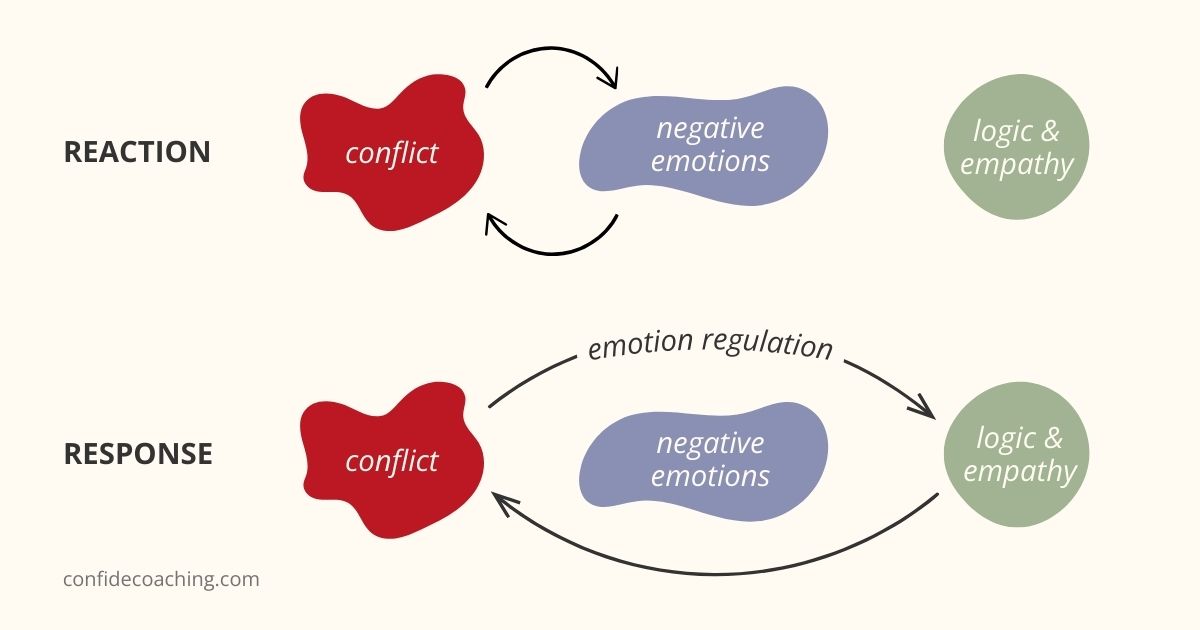
The Balance Between Acceptance and Change
Understanding when to accept and delve into a negative emotion versus when to actively change it is a nuanced skill. It involves self-awareness and honesty. Remember that all emotions are valid, but not all require the same response. By assessing the usefulness of each emotion, you empower yourself to make choices that promote your well-being and align with your values.
Cognitive Reappraisal: Changing the Way We Think
The Science Behind Cognitive Reappraisal
Definition
Cognitive reappraisal is a psychological strategy where we consciously change our interpretation of a situation to alter its emotional impact. By rethinking the meaning we assign to events, we can modify how we feel about them. This doesn’t mean ignoring reality but rather viewing it through a different, often more constructive, lens.
Research Foundation
The concept of cognitive reappraisal was significantly developed by psychologist Richard Lazarus in the 1960s. Lazarus’s research demonstrated that our emotional responses are heavily influenced by our cognitive appraisals—the evaluations we make about how a situation affects our well-being. He showed that by shifting these appraisals, we can change our emotional experiences. For example, if we perceive a challenging situation as a threat, we may feel fear, but if we view it as an opportunity for growth, we might feel excited.
Cognitive reappraisal is a central component of cognitive-behavioral therapy (CBT), one of the most widely practiced forms of psychotherapy. CBT helps individuals identify and challenge negative thought patterns and beliefs, encouraging them to reframe their thinking in more positive or realistic ways.
Similarly, life coaches frequently employ cognitive reappraisal techniques to assist clients in achieving their personal and professional goals. While therapy often looks into problems in the past to address underlying psychological issues, life coaching focuses on the present and future. Life coaches help clients identify and challenge negative thought patterns that may be holding them back. By reframing these thoughts, clients can alter their emotional responses and behaviors in ways that promote personal growth and goal attainment.
For example, a life coach might work with someone who feels stuck in their career due to self-doubt. Through cognitive reappraisal, the coach guides the client to recognize and challenge limiting beliefs, such as “I’m not good enough.” By shifting this perspective to a more empowering one—like “I have valuable skills and can acquire new ones to progress”—the client experiences reduced anxiety and increased motivation. This change in thinking can lead to proactive steps like seeking additional training or applying for promotions.
In both therapy and life coaching, cognitive reappraisal serves as a powerful tool for transforming one’s emotional landscape. However, while therapy may delve into past experiences to heal and understand deep-rooted issues, life coaching is geared toward actionable strategies that impact the client’s current situation and future aspirations. By changing the way individuals think about their experiences, life coaches help clients alter their emotional responses, leading to improved well-being and success in various areas of life.
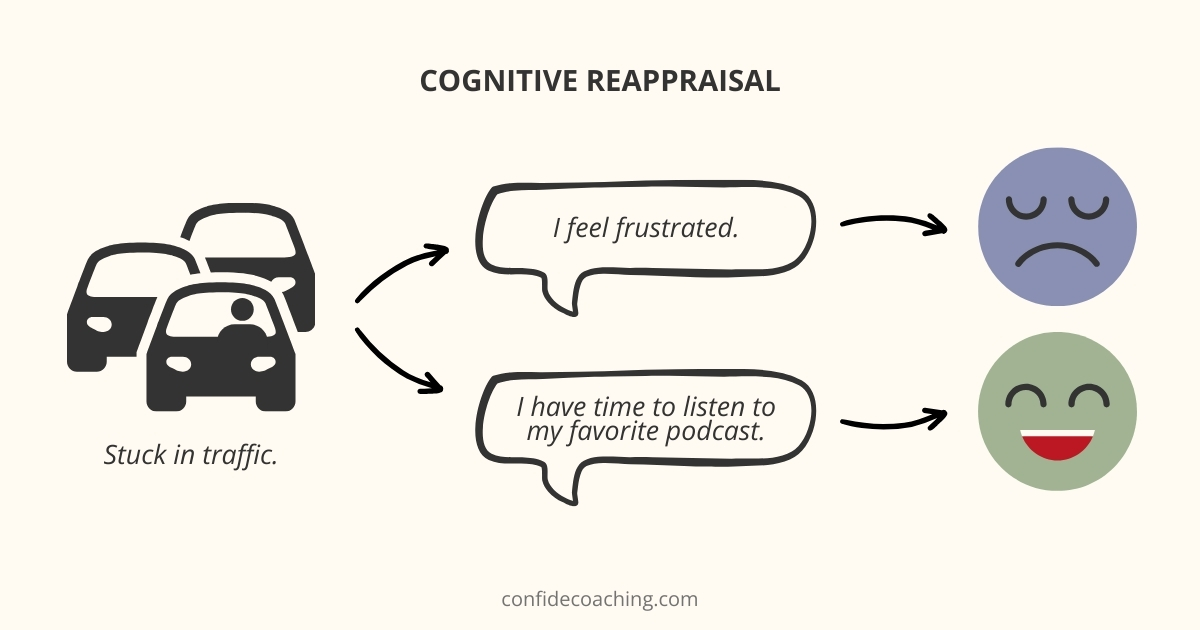
How Our Thoughts Influence Emotions
The Appraisal Process
At the heart of our emotional experiences lies the appraisal process. We constantly evaluate situations by comparing them to our desires, goals, and expectations. This evaluation determines our emotional response. If we perceive that a situation aligns with our goals, we might feel happiness or satisfaction. Conversely, if we perceive a mismatch, we might experience disappointment, frustration, or anger.
Gap Between Reality and Expectations
Emotions often arise from the discrepancy between how things are and how we want them to be. This “emotional gap” can lead to negative feelings when reality doesn’t meet our expectations. Recognizing this gap is crucial because it highlights the areas where cognitive reappraisal can be most effective. By adjusting either our interpretation of reality or our expectations, we can reduce this gap and the negative emotions associated with it.
Two Paths of Reappraisal
1. Reconstrual: Changing the Interpretation of the Situation
Technique
Reconstrual involves altering how we interpret a situation by viewing it from different angles or perspectives. This means considering alternative explanations or meanings that may be less distressing or more positive. It’s about challenging our initial, often automatic, interpretations and seeking a more balanced understanding.
Example
Imagine you receive a brief, curt email from a colleague. Your initial interpretation might be that they’re upset with you, leading to feelings of anxiety or annoyance. Through reconstrual, you consider other possibilities: perhaps they’re under pressure from tight deadlines, or they were in a hurry and didn’t have time for pleasantries. By changing your interpretation, you reduce negative emotions and maintain a better working relationship.
2. Repurposing: Adjusting Our Goals or Expectations
Technique
Repurposing focuses on modifying our goals or what we want from a situation to reduce the emotional gap. It involves reassessing our expectations and aligning them with reality or with what we can control. By adjusting our desired outcomes, we can alleviate the disappointment or frustration that comes from unmet expectations.
Example
Suppose you’re seeking approval from others to feel confident in your abilities. When praise isn’t forthcoming, you might feel unappreciated or discouraged. Through repurposing, you shift your goal from seeking external validation to focusing on self-improvement and personal satisfaction. By valuing your own growth and efforts, you reduce reliance on others for your sense of worth, leading to increased self-confidence and fulfillment.
Applying Both Paths Together
Sometimes, the most effective reappraisal involves a combination of reconstrual and repurposing. By simultaneously altering your interpretation of the situation and adjusting your goals, you can significantly transform your emotional experience.
Integrated Example
Let’s revisit the scenario of receiving a curt response from a colleague:
- Reconstrual: You consider that your colleague may be stressed due to personal issues or a heavy workload, which explains their abruptness.
- Repurposing: You adjust your expectations from wanting every interaction to be friendly to understanding that professionalism doesn’t always include warmth, and that’s okay.
Now that we understand the two paths of reappraisal, let’s explore how to apply them practically in our daily lives.
Practical Steps to Apply Cognitive Reappraisal
Step-by-Step Guide
Cognitive reappraisal is a skill that can be developed with practice. Here is a step-by-step guide to help you apply this strategy in your daily life.
1. Identify the Emotion and Its Triggers
Self-Awareness: Begin by acknowledging what you’re feeling without judgment. Recognize the emotion—whether it’s anger, sadness, anxiety, frustration, or any other feeling. Accept that it’s a natural response and that all emotions are valid.
Example: “I’m feeling anxious right now.”
Mindfulness Practice: Stay present and observe your thoughts and bodily sensations. Mindfulness helps you become aware of your internal experiences without getting swept away by them.
Technique: Take a few deep breaths and focus on the present moment. Notice where you feel the emotion in your body—perhaps tension in your shoulders or a knot in your stomach.
While mindfulness helps you become aware of your emotions, accurately identifying them is equally crucial. Tools like How We Feel app (howwefeel.org) can be incredibly helpful. This app provides a rich vocabulary of emotions beyond the basic categories, helping you pinpoint exactly what you’re feeling.
Benefits of Accurately Naming Your Emotions
Being able to precisely identify and name your emotions offers several significant benefits:
- Enhanced Self-Awareness: Accurately labeling your emotions deepens your understanding of your internal state. It moves you beyond vague feelings into specific awareness, which is the first step toward effective management. Instead of a general sense of feeling “bad,” you might recognize that you’re actually feeling “overwhelmed” or “disappointed.”
- Improved Emotional Regulation: When you know exactly what emotion you’re dealing with, you can apply targeted strategies to address it. Different emotions may require different coping mechanisms. The way you cope with anxiety might differ from how you handle frustration.
- Reduced Emotional Intensity: Research suggests that simply naming an emotion can diminish its intensity. This process, known as “affect labeling,” helps activate the prefrontal cortex, which is involved in regulating emotions. For example, saying to yourself, “I’m feeling nervous,” can help calm the emotional response associated with that feeling.
- Better Communication: Accurately identifying your emotions enables you to communicate them more effectively to others, fostering understanding and support. Telling a friend, “I’m feeling isolated,” can prompt a more supportive response than simply saying, “I’m not feeling great.”
- Guided Action: Understanding the specific emotion can guide you toward appropriate actions to address the underlying issue. Recognizing that you’re feeling “unappreciated” at work might motivate you to have a constructive conversation with your supervisor.
With a clear understanding of the specific emotions you’re experiencing and the benefits of accurately naming them, you’re now better equipped to delve deeper into the underlying causes of these feelings. The next step is to examine your thoughts about the situation, which will help you identify patterns in your thinking that may be intensifying your emotional responses.
2. Examine Your Thoughts About the Situation
Challenge Automatic Thoughts: Analyze the initial interpretations that led to your emotional response. Ask yourself if these thoughts are accurate or if they might be distorted or exaggerated.
Questions to Ask:
- “Is there concrete evidence supporting my thoughts?”
- “Am I jumping to conclusions?”
Question Absolutes: Be cautious of using absolute terms like “always,” “never,” or “everyone” in your self-talk, as they can amplify negative emotions.
Incorporating Byron Katie’s “The Work” to Challenge Your Thoughts
To delve deeper into challenging your thoughts, you can utilize the approach developed by Byron Katie, a renowned expert in self-inquiry and cognitive restructuring. Her method, known as “The Work,” involves asking four profound questions that help you investigate and question the validity of your thoughts.
The Four Questions of The Work:
- Is it true?
- Can I absolutely know that it’s true?
- How do I react—what happens—when I believe that thought?
- Who would I be without that thought?
Example
Suppose you’re thinking, “I’m not good enough.” Applying The Work questions can look like this:
1. Is it true?
Ask yourself honestly whether the statement “I’m not good enough” is true.
Answer: “I feel like it’s true because I didn’t get the promotion I was aiming for.”
2. Can I absolutely know that it’s true?
Consider whether you can be 100% certain that this thought is accurate in all aspects of your life.
Answer: “No, I can’t absolutely know that I’m not good enough. There are areas where I’ve succeeded and been recognized.”
3. How do I react—what happens—when I believe that thought?
Observe the emotions, physical sensations, and behaviors that arise when you hold onto this belief.
Answer: “When I believe that I’m not good enough, I feel discouraged, anxious, and unmotivated. I start to doubt myself, avoid challenges, and may even withdraw from opportunities. Physically, I feel tension in my shoulders and a heaviness in my chest.”
4. Who would I be without that thought?
Imagine how you would feel and act if you didn’t have this limiting belief.
Answer: “Without the thought ‘I’m not good enough,’ I would feel more confident and at ease. I’d be open to new experiences, willing to take on challenges, and more likely to recognize and celebrate my achievements. I’d engage with others more positively and take proactive steps toward my goals.”
Turnaround Statements
Byron Katie suggests creating “turnaround” statements to explore the opposite or alternative perspectives of your original thought.
Original Thought: “I’m not good enough.”
Turnaround to the Opposite: “I am good enough.”
- Evidence:
- “I’ve received positive feedback from my colleagues and superiors.”
- “I have successfully completed numerous projects.”
- ” Friends and family appreciate my support and advice.”
Turnaround to the Self: “I’m not good enough at believing in myself.”
- Evidence:
- “Sometimes I underestimate my abilities despite evidence of my accomplishments.”
- “I tend to focus on my shortcomings rather than my strengths.”
Turnaround to Others: “Others too may feel they’re not good enough.”
- Reflection:
- “Many people experience self-doubt; I’m not alone in this feeling.”
- “Understanding this can help me connect with others and offer support.”
Reflect on the Turnarounds
By considering these turnarounds, you recognize that the absolute statement “I’m not good enough” isn’t accurate. This realization helps diminish the negative emotional impact of the original thought.
Applying The Work to Your Thought Process
- Acknowledge Achievements: Make a list of your accomplishments and strengths to reinforce evidence against the negative belief.
- Embrace a Growth Mindset: Understand that not achieving a specific goal doesn’t define your overall worth. Use setbacks as learning opportunities and approach success in a more flexible way by focusing on the process of improvement rather than viewing the desired result as the only metric for measuring success.
- Cultivate Self-Compassion: Treat yourself with kindness and recognize that everyone at some point in their life or career faces challenges and makes mistakes.
By applying techniques like cognitive reappraisal and Byron Katie’s “The Work,” you can effectively challenge and transform negative thought patterns. However, even with these tools, you may encounter obstacles in regulating your emotions. It’s important to recognize that managing emotions is not always straightforward, and factors like meta-emotions—emotions about your emotions—can complicate the process. In the next section, we’ll explore common challenges in emotion regulation and provide strategies to overcome them, helping you navigate your emotional landscape more effectively.
Overcoming Obstacles in Emotion Regulation
Dealing with Meta-Emotions (Emotions About Emotions)
An essential yet often overlooked aspect of emotion regulation is dealing with meta-emotions—the emotions we feel about our own emotions. For instance, you might:
- Feel shame about feeling anxious, thinking you shouldn’t be worried.
- Experience guilt for feeling angry, believing that anger is unjustified.
- Feel frustrated that you’re sad, wishing you could just “cheer up.”
- Be embarrassed about feeling jealous, thinking it’s immature.
- Feel angry at yourself for feeling afraid, believing you should be braver.
- Experience disappointment in yourself for feeling overwhelmed, thinking you should handle things better.
- Feel anxious about feeling happy, fearing that something bad might follow.
- Feel sadness about feeling disconnected, wishing you could feel more engaged.
- Experience resentment toward yourself for feeling envy, thinking you should be more content.
- Feel hopeless because you’re still grieving, believing you should have moved on by now.
These secondary emotions can complicate our emotional experiences and make regulation more challenging. They often lead to a cycle where one negative emotion triggers another, intensifying overall emotional distress. This cascading effect is closely tied to the trap of self-judgment.
The Trap of Self-Judgment
Negative judgments about our emotions can intensify emotional distress and create a vicious cycle. When we label certain emotions as “bad” or “weak,” we may suppress or deny them, which can lead to increased anxiety, depression, or other mental health issues. By criticizing ourselves for how we feel, we not only experience the initial negative emotion but also add layers of additional suffering through self-judgment.
Self-judgment prevents us from accepting our emotions and understanding their underlying messages. Instead of viewing emotions as valuable signals that offer insights into our needs and experiences, we may see them as flaws to eliminate. This perspective hinders our ability to process emotions effectively and can exacerbate the very feelings we’re trying to avoid.
Connecting Meta-Emotions and Self-Judgment
When we experience meta-emotions, such as feeling angry about being anxious, we’re engaging in self-judgment. This internal criticism can:
- Intensify Negative Emotions: The original emotion (e.g., anxiety) is compounded by the secondary emotion (e.g., anger), making the overall experience more distressing.
- Create a Vicious Cycle: Negative feelings about our emotions lead to more negative emotions, trapping us in a loop that’s hard to break.
- Inhibit Emotional Processing: Self-judgment can prevent us from acknowledging and addressing the root causes of our feelings, impeding healing and growth.
Example:
-
Initial Emotion: You feel anxious about an invitation to present at an upcoming event.
- Meta-Emotion: You then feel ashamed for being anxious, thinking you should be more confident.
- Self-Judgment Cycle:
- Thought: “I feel anxious because I know I’m not good enough and if I accept the invitation everyone will know the truth. I’m such an imposter.”
- Emotional Impact: The shame intensifies your anxiety, possibly leading to increased stress or avoidance behaviors. You deny the invitation and reinforce the internal negative belief that you are unworthy and not good enough.
Breaking the Cycle of Self-Judgment
Dealing with meta-emotions and self-judgment can be challenging, but it’s crucial to break free. To move forward, we need to shift our perspective and embrace change. Self-reflection and journaling, using techniques like Byron Katie’s “The Work” (discussed previously), can be effective for those comfortable with self-help. However, therapy or life coaching can be beneficial for individuals caught in a cycle of emotional turmoil and rumination, offering a safe space for exploration and guidance.
Additionally, a helpful strategy is to imagine advising a friend in the same situation. We often offer compassion to others more easily than to ourselves. By stepping outside our perspective, we gain clarity and break free from self-judgment, remembering that we deserve the same empathy we extend to others.
How to Practice Advising a Friend Technique
1. Identify a Challenging Situation
- Think about a situation where you’re experiencing negative emotions or harsh self-judgment.
- Example: You made a mistake at work and are criticizing yourself for being “incompetent.”
2. Visualize a Friend in Your Shoes
- Imagine a close friend or loved one is dealing with the exact same issue.
- Consider how you would perceive their situation and what feelings it might evoke in you.
3. Offer Compassionate Advice
- Think about the advice, support, or encouragement you would offer them.
Questions to Consider:- What words of comfort would you share?
- How would you help them see the situation differently?
- What practical steps might you suggest they take?
4. Write It Down
- Jot down your advice in a letter or note addressed to your friend.
- Be as detailed and compassionate as possible.
5. Apply the Advice to Yourself
- Read the letter back to yourself, recognizing that the guidance applies to you.
- Reflect on how this perspective shifts your feelings about the situation.
6. Take Action Based on the New Perspective
- Implement any practical steps or changes in thinking that emerged from the exercise.
- Example: Decide to view the mistake as a learning opportunity and plan how to prevent it in the future.
This exercise offers numerous benefits. It reduces self-criticism and encourages a kinder internal dialogue. It also enhances problem-solving skills, opening up new perspectives. Additionally, it builds emotional resilience, strengthening your ability to cope with challenges.
For best results, practice regularly. Use this technique whenever negative thought patterns arise. Combine it with mindfulness or journaling for even deeper insights. And remember, if self-judgment persists, seeking support from a therapist or life coach can be beneficial.
Despite these challenges, mastering emotion regulation offers significant benefits, particularly in achieving our goals.
The Impact of Emotion Regulation on Achieving Goals
Emotions Influence Actions
Connection Between Emotions and Behavior
Our emotions play a significant role in shaping our decisions and actions. When we’re emotionally balanced, we’re better equipped to think clearly, assess situations objectively, and make choices that align with our goals and values. Conversely, unmanaged emotions can cloud our judgment, leading to impulsive decisions or actions that may hinder our progress.
For example, feeling overwhelmed by stress might cause us to procrastinate or avoid tasks that are crucial for achieving our objectives. On the other hand, managing stress through emotion regulation techniques can help us stay focused and productive.
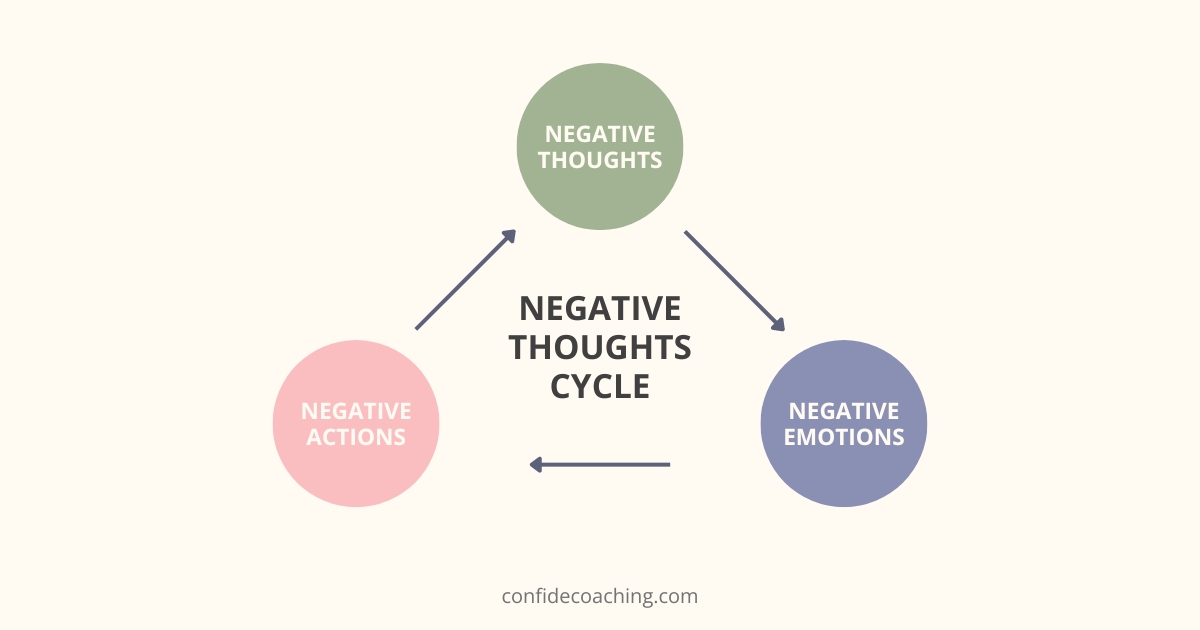
Positive Outcomes of Regulated Emotions
Emotion regulation offers numerous benefits that positively impact various aspects of our lives. Here are some key areas where managing our emotions can make a significant difference:
1. Better Decision-Making
When we regulate our emotions, we’re less likely to make hasty decisions based on temporary feelings. This allows for more thoughtful and strategic choices that support our long-term goals.
Example: Instead of reacting defensively to constructive criticism, regulated emotions enable us to receive feedback openly and use it to improve.
In addition to fostering better decision-making, emotion regulation also enhances our relationships with others.
2. Enhanced Relationships
By managing our emotional responses, we communicate more effectively, resolve conflicts amicably, and build stronger connections. Emotion regulation fosters healthier interactions that are crucial for personal and professional success.
Example: In a team setting, staying calm during a disagreement helps maintain a collaborative environment, leading to better outcomes for group projects.
Beyond improving decision-making and relationships, regulated emotions increase our resilience in the face of challenges.
3. Increased Resilience
Regulated emotions contribute to our ability to cope with setbacks and obstacles. This resilience is essential for persevering toward our goals despite difficulties that may arise along the way.
Example: Handling disappointment after a failed attempt with composure allows us to learn from the experience and try again with renewed effort.
Long-Term Benefits
1. Enhanced Well-Being
- Reduced Stress: Regularly practicing emotion regulation techniques can lower stress levels by preventing negative emotions from overwhelming us. This leads to improved mental and physical health.
Example: Incorporating mindfulness exercises or breathing techniques into your routine can decrease anxiety and promote a sense of calm. It will also help you become less reactive as these practices teach you distancing techniques and the ability to observe your thoughts and feelings without getting overwhelmed by them.
- Increased Happiness: By managing unhelpful emotions (those that keep us stuck) and fostering helpful ones (the ones that move us forward), we can overtime cultivate a more optimistic outlook on life. This contributes significantly to our overall happiness and life satisfaction. We spend less time ruminating and become more open to life.
2. Improved Relationships
- Better Communication: Emotion regulation allows us to express our feelings constructively, making it easier to communicate needs and understand others.
Example: Using “I” statements to convey feelings during a difficult conversation can prevent misunderstandings and promote empathy.
- Greater Empathy and Understanding: When we’re attuned to our emotions, we’re better able to recognize and empathize with the emotions of others, strengthening our relationships.
Example: Being aware of your own frustration helps you respond patiently when someone else is struggling.
3. Greater Success
- Focus on Goals: Emotion regulation helps maintain focus and motivation, even when faced with distractions or setbacks. This persistence is key to achieving long-term objectives.
Example: Managing feelings of boredom or frustration during a complex project enables you to stay engaged and see it through to completion.
- Adaptability: Regulated emotions enhance our ability to adapt to changing circumstances, which is crucial for success in various aspects of life.
Example: Remaining calm during unexpected changes at work allows you to adjust your plans effectively without becoming overwhelmed.
By mastering emotion regulation, we empower ourselves to navigate life’s challenges more effectively. This not only aids in achieving personal and professional goals but also enhances our overall quality of life. Emotionally intelligent individuals are more likely to experience success, satisfaction, and fulfillment.
Conclusion
Mastering your emotions is not about suppressing or ignoring them but about understanding and strategically responding to them. Throughout this article, we’ve explored how emotions—even the negative ones—serve as valuable signals that can guide personal growth and well-being. By recognizing and embracing these signals, you empower yourself to transform negative thoughts and feelings into positive actions.
You now have a toolkit of proven strategies—such as cognitive reappraisal, mindfulness practices, Byron Katie’s method “The Work” and the “Advising a Friend” technique—to help you navigate your emotional landscape effectively. These tools enable you to challenge unhelpful thought patterns, reduce self-judgment, and foster a more compassionate relationship with yourself.
Now is the time to take action. Start integrating these strategies into your daily life to experience their transformative effects. Begin by practicing mindfulness to increase your self-awareness. Use cognitive reappraisal and the four questions from The Work to shift your perspective on challenging situations. When faced with negative self-talk, apply the “Advising a Friend” technique to offer yourself the compassion you deserve.
Remember, personal growth is a journey that often benefits from support. If you find yourself struggling or wish to deepen your emotional mastery, consider reaching out to a life coach or therapist. They can provide personalized guidance tailored to your unique experiences and help you navigate obstacles more effectively.
Don’t wait for change to happen—take the first step today. Embracing the full spectrum of your emotions is a courageous act that leads to a more fulfilling and balanced life. By doing so, you open yourself up to deeper self-understanding, resilience, and the ability to face life’s challenges with confidence and grace.
Your emotions are not obstacles but allies on your path to personal growth. Harness them, learn from them, and let them guide you toward a richer, more empowered existence. The journey to emotional mastery begins with a single step—why not take it now?

Paul Strobl, MBA, CPC
Owner of Confide Coaching, LLC
Paul is a Master Life Coach for GenX and GenY executives and business owners. Originally from Houston, Texas, he has been location independent for most of his adult life. He currently resides in the Rhodope Mountains of Bulgaria near the Greek border with his brilliant wife, 14-year-old stepson (officially adopted in 2021!) and a Posavac Hound rescue.
References
Gross, J. J. (1998). The Emerging Field of Emotion Regulation: An Integrative Review. Review of General Psychology, 2(3), 271–299.
Lazarus, R. S., & Folkman, S. (1984). Stress, Appraisal, and Coping. New York: Springer Publishing Company.
Beck, A. T. (1976). Cognitive Therapy and the Emotional Disorders. New York: International Universities Press.
Katie, B., & Mitchell, S. (2002). Loving What Is: Four Questions That Can Change Your Life. New York: Harmony Books.
Dweck, C. S. (2006). Mindset: The New Psychology of Success. New York: Ballantine Books.
Neff, K. D. (2015). Self-Compassion: The Proven Power of Being Kind to Yourself. New York: William Morrow.
Kabat-Zinn, J. (1990). Full Catastrophe Living: Using the Wisdom of Your Body and Mind to Face Stress, Pain, and Illness. New York: Delacorte Press.
How We Feel Project, Inc. (n.d.). How We Feel App. Retrieved from https://howwefeel.org/

